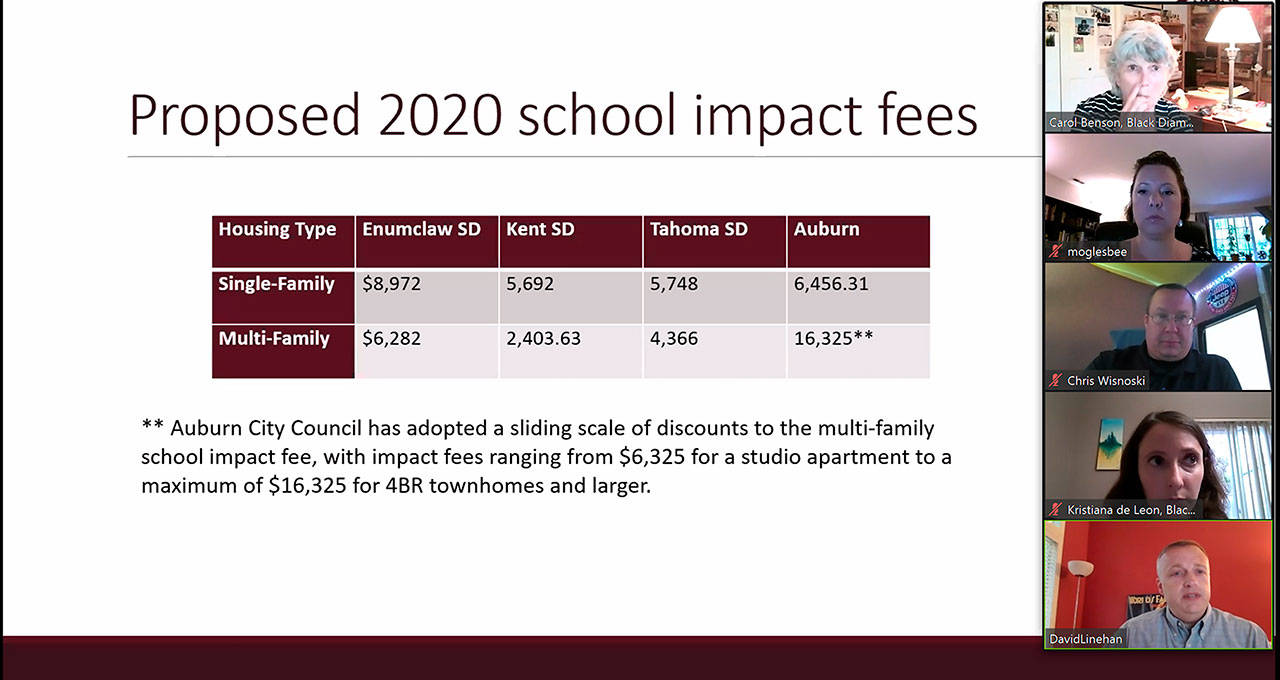The Black Diamond City Council discussed a number of exciting topics during their last meeting, including setting up a school impact fee ordinance.
However, before work began on the Aug. 6 meeting, Councilman Patrick Nelson made a surprise announcement.
“This is hard. I’m officially stepping down as a council member,” he said, adding that he’s had to move out of the city to help family. “I’m not going away, I’m just not living there… you’ll still see me around.”
Of course, this means Nelson’s seat — which he himself was appointed to on Sept. 19, 2019 — will be open once again, and the city will soon start accepting applications to name a new appointee.
After Nelson recused himself of any further votes, the council began talking about implementing school impact fees.
For those not in the know, impact fees of any kind are a one-time charge on new housing developments that can go toward various amenities that would be put under more strain because of those additional housing units. This idea falls under the colloquial “growth paying for growth” umbrella.
Impact fees can collect money for anything from transportation and traffic, parks, fire protection, or, in this case, schools.
However, impact fees are not a silver bullet when it comes to population growth helping mitigate school costs, and there are strict rules.
For example, while school districts are often relied upon to calculate how much revenue they’d need to see to keep up with the population growth of their area, local cities decide exactly how much the impact fee will actually be, and according to the Washington-based Municipal Research and Services Center, it’s very common for cities (or school districts) to automatically cut the impact fee in half.
While school impact fees can pay for any sort of system improvements, the revenue cannot be spent on improvements that were already needed when the school impact fees are adopted.
“If there’s a lack of space already existing or other facilities that needed to be built anyway, regardless of growth, the impact fees are not appropriate for those purposes,” said city attorney David Linehan.
Additionally, school impact fees cannot be the sole source of revenue for a school project or improvement.
“There must be some general revenue that is used,” Linehan added.
Finally, commercial developments are not affected by impact fees, and exceptions or waivers can be made for certain kinds of housing developments, like low-income housing or auxiliary dwelling units (ADUs), to encourage developers to build more of certain kinds of housing.
There are two reasons why Black Diamond is seriously looking at ways to increase support for their area schools.
First is that the Ten Trails and Lawson Hills housing developments, which fall under a Master Plan Development by developer Oakpoine, are expected to increase the city’s population from around 4,200 to more than 19,000. This would put a strain on any school district, even though that population increase is expected to occur at a steady pace over a couple of decades.
Second, Black Diamond doesn’t reside in one school district, but four — Enumclaw, Tahoma, Kent, and Auburn.
“Adopting the impact fee ordinance would ensure that all the [housing] development in the city is providing mitigation for schools,” said Linehan. “Right now, outside of the Ten Trails development, there are no residential developments that have to pay school mitigation. By adopting this ordinance, all the resident development in the city will be covered.”
While Black Diamond doesn’t currently have school impact fees established in city code, the city, Oakpointe, and the Enumclaw School Districted signed in 2011 a Comprehensive School Mitigation Agreement (CSMA) which acts very similar to school impact fees; for every single-family housing unit built in Ten Trails or Lawson Hills, the Enumclaw School District gets $7,783, and for every multi-family housing unit, $2,502.
Based on Enumclaw’s calculations on how Black Diamond growth will impact the school district, the district would actually like to receive $8,972 and $6,282 for single- and multi-family housing developments respectively.
However, based on the CSMA, the district will actually be limited to a maximum impact fee of $4,003 for multi-family housing.
The Kent School District is requesting impact fees of $5,692 for single-family home development and $2,403.63 for multi-family developments; the Tahoma District $5,748 for single-family and $4,366 for multi-family; and Auburn wants $6,456.31 for single-family (the city of Auburn has a sliding scale for multi-family developments ranging from $6,325 for studio apartments to $16,325 for four-bedroom townhouses or larger).
During the public hearing, many Black Diamond residents and advocates voiced concern about the 50 percent discount normally imposed on impact fees, saying they’d like Oakpointe (and other developers) to more in school impact fees.
Additional discussion about the impact fees, and a vote of the council whether or not to implement them, are expected during the Aug. 20 meeting.


